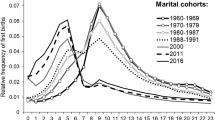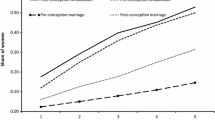Abstract
This paper investigates the subsequent fertility of British women who have experienced the dissolution of their first marriage in recent decades. Data for 7739 women from the 1990–1995 General Household Surveys are used to examine the socio-demographic factors associated with experiencing a post-dissolution birth. Just under one half of women who had experienced marital dissolution went on to experience a conception within twelve years. A women's age and her repartnering status are shown to be the factors most strongly associated with the probability of a post-dissolution conception. The age of a woman's youngest child is found to be more strongly associated with her likelihood of experiencing a conception than her parity at marital dissolution.
Similar content being viewed by others
References
Allison, P.D., 1984. Event History Analysis: Regression for Longitudinal Data. Sage University Paper series on Quantitative Applications in the Social Science, 07-046. Sage Publications, Beverley Hills.
Bachrach, C.A., 1987. 'Cohabitation and reproductive behaviour in the U.S.'. Demography 24: 623–637.
Berrington, A. and Diamond, I., 2000. 'Marriage or cohabitation? a competing risks analysis of first partnership formation amongst the 1958 British birth cohort'. Journal of The Royal Statistical Society (Series A) 163(2): 127–152.
Burgoyne, J. and Clark, D., 1984. Making a Go of It. Routledge and Kegan Paul, London, Boston, Melbourne and Henley.
Clarke, S., Diamond, I., Spicer, K. and Chappell, R., 1993. 'The relationship between marital breakdown and childbearing in England and Wales', in M. Ni Bhrolchain (ed.), New Perspectives on Fertility in Britain. HMSO, London, 123–136.
Clarke, K., Glendinning, C. and Craig, G., 1994. Losing Support: Children and the Child Support Act. The Children's Society, London.
Coleman, D., 1989. 'The contemporary pattern of remarriage in England and Wales', in E. Grebenik, C. Hohn and R. Mackensen (eds), Later Phases of the Family Cycle; Demographic Aspects. Oxford University Press.
Council of Europe, 1997. Recent Demographic Developments in Europe 1997. Strasburg Council of Europe Publishing.
De Cooman, E., Ermisch, J. and Joshi, H., 1987. 'The next birth and the labour market: a dynamic model of births in England and Wales'. Population Studies 41: 237–268.
Diamond, I., Clarke, S. and Clarke, P., 1995. The Impact of Marital Breakdown on the Quantum and Tempo of Childbearing in England and Wales. Paper presented at European Population Conference, Milan, September 4-8, 1995.
Ermisch, J.F. and Wright, R.E., 1991. 'The duration of lone parenthood in Great Britain'. European Journal of Population 7: 129–158.
Griffith, J. D., Koo, H.P. and Suchindran, C.M., 1985. 'Childbearing and family in remarriage'. Demography 22: 73–88.
Haskey, J., 1987. 'Social class differentials in remarriage after divorce: results from a forward linkage study'. Population Trends 47: 34–42.
Haskey, J., 1995. 'Trends in marriage and cohabitation: the decline in marriage and the changing pattern of living in partnerships'. Population Trends 80: 5–15.
Haskey, J., 1996. 'The proportion of married couples who divorce: past patterns and current prospects'. Population Trends 83: 25–36.
Jefferies, J., 1997. Childbearing After Marital Breakdown in Britain. Paper presented at British Society for Population Studies Annual Conference, Exeter, 1-3 September 1997.
Joshi, H., 1984. Women's Participation in Paid Work: Further Analysis of the Women and Employment Survey. Department of Employment Research Paper 45, London.
Kiernan, K.E. and Estaugh, V., 1993. Cohabitation: Extra-marital Childbearing and Social Policy. Family Policy Studies Centre, London.
Koo, H.P., Suchindran, C.M. and Griffith, J.D. 1984. 'The effects of children on divorce and remarriage: a multivariate analysis of life table probabilities'. Population Studies 38: 451–471.
Lampard, R. and Peggs, K., 1996. Couple Formation After the End of Marriage or Cohabitation: Issues of Gender and Parenthood. Paper presented at British Society for Population Studies Annual Conference, 2-5 September 1996.
Laybourn, A., 1994. The Only Child: Myths and Reality. HMSO, Edinburgh.
Lillard, L.A. and Waite, L.J., 1993. 'A joint model of marital childbearing and marital disruption'. Demography 30(4): 653–681.
Loomis, L.S. and Landale, N.S., 1994. 'Nonmarital cohabitation and childbearing among black and white American women'. Journal of Marriage and the Family 56: 949–962.
Ni Bhrolchain, M., 1986a. 'Women's paid work and the timing of birth-longitudinal evidence'. European Journal of Population 2: 43–70.
Ni Bhrolchain, M., 1986b. 'The interpretation and role of work-associated accelerated childbearing in post-war Britain'. European Journal of Population 2: 135–154.
Ni Bhrolchain, M., 1988. 'The contraceptive confidence idea: an empirical investigation'. Population Studies 42: 205–225.
Ni Bhrolchain, M., 1993. 'Recent fertility differentials in Britain', in M. Ni Bhrolchain (eds), New Perspectives on Fertility in Britain. HMSO, London, 95–109.
Office for National Statistics, 1997. 1994 Marriage and Divorce Statistics, England and Wales, Series FM2, no. 22. The Stationery Office, London.
Office of Population Censuses and Surveys, 1990. 1837-1983 Marriage and Divorce Statistics, Historical Series, England and Wales. Series FM2, no. 16. HMSO, London.
Rindfuss, R.R. and Bumpass, L.L., 1977. 'Fertility during marital disruption'. Journal of Marriage and the Family 39: 517–528.
Suchindran, C.M., Koo, H.P. and Griffith, J.D., 1985. 'The effects of post-marital childbearing on divorce and remarriage: an application of hazards models with time-dependent covariates'. Population Studies 39: 471–486.
Thomson, E., 1997. Her, His and Their Children: Influences on Couple Childbearing Decisions, NSFH Working Paper No. 76. Center for Demography and Ecology, University of Wisconsin-Madison.
Vikat, A., Thomson, E. and Hoem, J.M., 1999. 'Stepfamily fertility in contemporary Sweden: the impact of childbearing before the current union'. Population Studies 53: 211–225.
Wineberg, H., 1990. 'Childbearing after remarriage'. Journal of Marriage and the Family 52: 31–38.
Wright, R.E., Ermisch, J.F., Hinde, P.R.A. and Joshi, H.E., 1988. 'The 3rd birth in Great Britain'. Journal of Biosocial Science 20: 489–496.
Wu, Z. and Wang, H., 1998. 'Third birth intention and uncertainty in Canada'. Social Biology 45: 96–112.
Author information
Authors and Affiliations
Rights and permissions
About this article
Cite this article
Jefferies, J., Berrington, A. & Diamond, I. Childbearing Following Marital Dissolution in Britain. European Journal of Population 16, 193–210 (2000). https://doi.org/10.1023/A:1026529300659
Issue Date:
DOI: https://doi.org/10.1023/A:1026529300659




